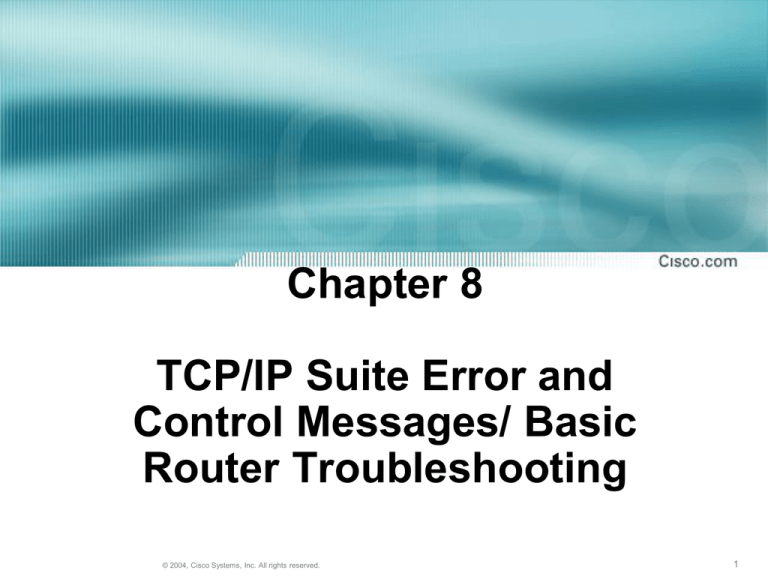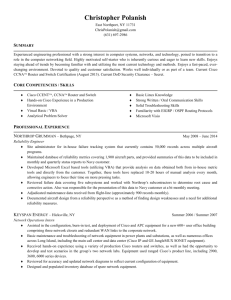
Chapter 8
TCP/IP Suite Error and
Control Messages/ Basic
Router Troubleshooting
© 2004, Cisco Systems, Inc. All rights reserved.
1
Objectives
© 2004, Cisco Systems, Inc. All rights reserved.
2
Internet Control Message Protocol
(ICMP)
© 2004, Cisco Systems, Inc. All rights reserved.
3
Error Reporting and Error Correction
• ICMP is an error-reporting protocol for IP.
© 2004, Cisco Systems, Inc. All rights reserved.
4
ICMP Message Delivery
• ICMP messages are encapsulated as data
in datagrams in the same way any other
data is delivered using IP.
© 2004, Cisco Systems, Inc. All rights reserved.
5
Unreachable Networks
© 2004, Cisco Systems, Inc. All rights reserved.
6
Ping
© 2004, Cisco Systems, Inc. All rights reserved.
7
Detecting Excessively Long Routes
• Whether the actual path includes too many hops
or a circular routing path exists, the packet will
eventually reach the end of its life, known as its
time-to-live (TTL).
© 2004, Cisco Systems, Inc. All rights reserved.
8
ICMP Message Types
© 2004, Cisco Systems, Inc. All rights reserved.
9
Destination Unreachable Message
© 2004, Cisco Systems, Inc. All rights reserved.
10
Code Values for Destination
Unreachable Messages
© 2004, Cisco Systems, Inc. All rights reserved.
11
TCP/IP Suite Control Messages
• Control messages are used to inform
hosts of conditions such as network
congestion or the existence of a better
gateway to a remote network.
© 2004, Cisco Systems, Inc. All rights reserved.
12
ICMP Redirect/Change Requests
The default gateway
of the host may
need to use a
redirect/change
request to inform
the host of the best
path to a certain
network.
© 2004, Cisco Systems, Inc. All rights reserved.
13
Clock Synchronization and Transit Time
Estimation
• The ICMP timestamp request message
allows a host to ask for the current time
according to the remote host.
• The remote host uses an ICMP timestamp
reply message to respond to the request.
© 2004, Cisco Systems, Inc. All rights reserved.
14
Address Mask Requirements
• When a network administrator uses the
process of subnetting to divide a major IP
address into multiple subnets, a new
subnet mask is created.
© 2004, Cisco Systems, Inc. All rights reserved.
15
Router Discovery Message
• When a host on the network boots, and
the host has not been manually
configured with a default gateway, it can
learn of available routers through the
process of router discovery.
© 2004, Cisco Systems, Inc. All rights reserved.
16
Router Solicitation Message
• A host generates an ICMP router
solicitation message in response to a
missing default gateway.
© 2004, Cisco Systems, Inc. All rights reserved.
17
Congestion and Flow Control
Messages
ICMP source-quench messages are
used to reduce the amount of data lost
from congestion.
© 2004, Cisco Systems, Inc. All rights reserved.
18
Summary
© 2004, Cisco Systems, Inc. All rights reserved.
19
Basic Router Troubleshooting
© 2004, Cisco Systems, Inc. All rights reserved.
20
Objectives
© 2004, Cisco Systems, Inc. All rights reserved.
21
The show ip route Command
The show ip route command displays the
contents of the IP routing table.
© 2004, Cisco Systems, Inc. All rights reserved.
22
Static Routing
© 2004, Cisco Systems, Inc. All rights reserved.
23
Dynamic Routing
© 2004, Cisco Systems, Inc. All rights reserved.
24
Default Route
© 2004, Cisco Systems, Inc. All rights reserved.
25
Configuring a Default Route
© 2004, Cisco Systems, Inc. All rights reserved.
26
Determining Route Source and
Destination
© 2004, Cisco Systems, Inc. All rights reserved.
27
Determining L2 and L3 Addresses
© 2004, Cisco Systems, Inc. All rights reserved.
28
Determining Administrative Distance
© 2004, Cisco Systems, Inc. All rights reserved.
29
Determining the Route Metric
Routing protocols use metrics to
determine the best route to a destination.
© 2004, Cisco Systems, Inc. All rights reserved.
30
Determining the Route Next Hop
• Destination next hop associations
determine the best path and which router
to forward the packet to next. This router
represents the next hop on the way to the
final destination.
© 2004, Cisco Systems, Inc. All rights reserved.
31
Determining the Last Routing Update
• Use the following commands to find the
last routing update:
show ip route
show ip route network
show ip protocols
show ip rip database
© 2004, Cisco Systems, Inc. All rights reserved.
32
Observing Multiple Paths to a
Destination
• Some routing protocols support multiple
paths to the same destination.
• Unlike single path algorithms, these multipath algorithms permit traffic over multiple
lines, provide better throughput, and are
more reliable.
© 2004, Cisco Systems, Inc. All rights reserved.
33
Introduction to Network Testing
© 2004, Cisco Systems, Inc. All rights reserved.
34
Structured Approach to
Troubleshooting
© 2004, Cisco Systems, Inc. All rights reserved.
35
Typical Layer 1 Errors
• Broken cables
• Disconnected cables
• Cables connected to the
wrong ports
• Intermittent cable connection
• Wrong cables used for the
task at hand
• Transceiver problems
• DCE cable problems
• DTE cable problems
• Devices turned off
© 2004, Cisco Systems, Inc. All rights reserved.
36
Typical Layer 2 Errors
• Improperly configured serial
interfaces
• Improperly configured
Ethernet interfaces
• Improper encapsulation set
• Improper clock rate settings
on serial interfaces
• Network interface card (NIC)
problems
© 2004, Cisco Systems, Inc. All rights reserved.
37
Typical Layer 3 Errors
• Routing protocol not enabled
• Wrong routing protocol
enabled
• Incorrect IP addresses
• Incorrect subnet masks
© 2004, Cisco Systems, Inc. All rights reserved.
38
Layer 1 Problems in a Network
© 2004, Cisco Systems, Inc. All rights reserved.
39
Layer 3 Troubleshooting
Using Ping
© 2004, Cisco Systems, Inc. All rights reserved.
40
Layer 7 Troubleshooting
Using Telnet
© 2004, Cisco Systems, Inc. All rights reserved.
41
Troubleshooting Layer 1
Using show interfaces Command
The show interfaces serial command
© 2004, Cisco Systems, Inc. All rights reserved.
42
Troubleshooting Layer 2
Using show interfaces Command
© 2004, Cisco Systems, Inc. All rights reserved.
43
Troubleshooting Using show cdp
neighbors Command
© 2004, Cisco Systems, Inc. All rights reserved.
44
Troubleshooting Using show cdp
neighbors detail Command
© 2004, Cisco Systems, Inc. All rights reserved.
45
Troubleshooting Using traceroute
Command
© 2004, Cisco Systems, Inc. All rights reserved.
46
Troubleshooting Routing Issues
The show ip route Command
© 2004, Cisco Systems, Inc. All rights reserved.
47
Troubleshooting Routing Issues
The show ip protocols Command
© 2004, Cisco Systems, Inc. All rights reserved.
48
Troubleshooting Using show
controllers serial Command
The show controllers serial Command
© 2004, Cisco Systems, Inc. All rights reserved.
49
Introduction to debug
Debug syntax
© 2004, Cisco Systems, Inc. All rights reserved.
50
Summary
© 2004, Cisco Systems, Inc. All rights reserved.
51
Question/Answer
© 2004, Cisco Systems, Inc. All rights reserved.
52




